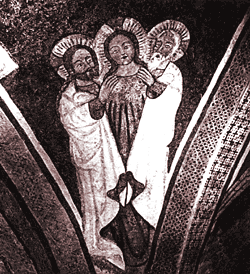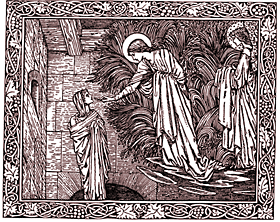
by Graham Brown

by Graham Brown
©Copyright Knowledge of Reality Magazine 1996-2006. All rights reserved. The name Novalis is not well known, however this mysterious pen name of the 18th century German poet, metallurgist, and aphorist Friederich von Hardenberg, is tantalisingly referred to in the works of some of the greatest minds in literature. How is it that a poet, whom the most famous of poets have idolised, remains in relative obscurity, only a fragment of his vast writings has been translated into English. Frustrating for those who have no German with which to open, what is apparently, a very rich treasury, and can only gather the few baubles German-speaking poets have dropped as they have left it. A comparatively recent anthology of some of the world’s most profound spiritual writings (‘The Enlightened Mind’) included a few of his thoughts with this short introduction:
The name Novalis is not well known, however this mysterious pen name of the 18th century German poet, metallurgist, and aphorist Friederich von Hardenberg, is tantalisingly referred to in the works of some of the greatest minds in literature. How is it that a poet, whom the most famous of poets have idolised, remains in relative obscurity, only a fragment of his vast writings has been translated into English. Frustrating for those who have no German with which to open, what is apparently, a very rich treasury, and can only gather the few baubles German-speaking poets have dropped as they have left it. A comparatively recent anthology of some of the world’s most profound spiritual writings (‘The Enlightened Mind’) included a few of his thoughts with this short introduction:
“the Holy and ardent Novalis,” Emerson called him. He was a scientist by trade, a pure romantic by nature. “The more poetic,” he wrote, “the more real. This is the core of my philosophy.”
 Novalis has been, and remains, one of the most vital influences in German literature; the modern mystics: Maeterlinck, Herman Hesse and Rilke (often considered the greatest poet of the twentieth century) admit a great debt to him. It has been argued that only Goethe and Holderlin, among his contemporaries, were of comparable stature- so why has his work been almost entirely overlooked by the English speaking world? Novalis’ short lifespan did not allow a great volume of work (as with Mozart and many others one wonders what he might have produced had he lived to a good age). Part of the problem may be the difficulty of translating writing which often seems obscure and ambiguous, perhaps because of the depth of the subjects tackled. Novalis expresses himself in a unique, personal style, almost as if he has discovered language by himself.
Novalis has been, and remains, one of the most vital influences in German literature; the modern mystics: Maeterlinck, Herman Hesse and Rilke (often considered the greatest poet of the twentieth century) admit a great debt to him. It has been argued that only Goethe and Holderlin, among his contemporaries, were of comparable stature- so why has his work been almost entirely overlooked by the English speaking world? Novalis’ short lifespan did not allow a great volume of work (as with Mozart and many others one wonders what he might have produced had he lived to a good age). Part of the problem may be the difficulty of translating writing which often seems obscure and ambiguous, perhaps because of the depth of the subjects tackled. Novalis expresses himself in a unique, personal style, almost as if he has discovered language by himself.
The charge of obscurity may be partly justified since Novalis himself wrote that he felt it necessary to develop a symbolic philosophical language for the purpose of protecting his deepest insights from those incapable of respecting them. In this he has not been alone- if we look at the words of the sufis we often find mystical concepts veiled in poetic terms. The young Novalis wrote: “Many people have thought that one ought to use a language of the wise for subtle subjects that might be profaned; for example one ought to write in Latin on such subjects. It would seem more to the point to try to speak in ordinary language in such a way that only those intended to understand could understand’. The principle mode of concealment is the use of imagery. Images are used to veil meaning, but for those who share Novalis’ love of symbolic imagery and subtle metaphor his language is a veil that enhances, rather than conceals, the beauty of his art. This use of concrete, palpable images overcame, to some extent, what he described as the “poverty of words”; and avoided the use of philosophical terms to express abstract concepts. In some instances spiritual qualities are personified as characters, human or divine, as they are in Hindu mythology.
Glad I dwell beneath the mountains
Smiling in the darkest night;
Here of love are many fountains
Flowing daily free and bright.
And Her sacred waters lift
my thirsty soul above to soar
Where , though still in life, I drift
Overcome, near Heaven’s door
Cradled there in adoration
Never fear can strike my soul
Mother Queen of every nation,
Cleanse my heart and make it whole
Perhaps part of the neglect stems from the fact that some have labelled him ‘ultra-irrational’ and ‘Ultra-Romantic’; Romanticism has been less popular in the drier Anglo-American tradition. Novalis is known as the originator of the central symbol of the German Romanticism, The Blue Flower; he shared in the movement’s deification of Nature, the demand for the Absolute, the idea of spiritual rebirth. It would be a mistake to call him a Romantic in the sense of the word brought to it by the excesses of Byron, for example. Though he is clearly associated with the strong mystical strain in German literature Novalis was a scientist in some respects; certainly the responsibilities of his ‘day job’ required a degree of scientific diligence; however, he seems to have appreciated the idea that it is necessary to balance the logic of science with the feeling of poetry: “The sciences must all be made poetic” he wrote. Perhaps, like his contemporary William Blake, he was trying to bring balance to the growing rationalism of the Enlightenment with a seemingly irrational spiritual ardency. Novalis, like other poets of the period, wanted to return to the sense of the Sacred found in the humbler Medieval tradition with its great mystics such as Hildegard von Bingen and Meister Eckhart.
 It is sometimes a mere reflex to categorise a piece of writing as romantic because it is addressing concepts of a metaphysical nature. The most profound insights of Novalis transcend not only right-brain logic but also left-brain emotionality- like the best selections from the Upanishads, or the sermons of the Buddha, they simply ring true in an indefinable way, defying our tendency to pigeonhole them.
It is sometimes a mere reflex to categorise a piece of writing as romantic because it is addressing concepts of a metaphysical nature. The most profound insights of Novalis transcend not only right-brain logic but also left-brain emotionality- like the best selections from the Upanishads, or the sermons of the Buddha, they simply ring true in an indefinable way, defying our tendency to pigeonhole them.
“For Novalis”, writes the scholar Bruce Haywood, “the poetic in the world was the only genuine reality, even as the poetic spirit in man was the proof of man’s divine origin. All of his poetry is concerned ultimately with revealing and celebrating the poetic spirit.”
Haywood and other Novalis scholars, have pointed out the importance of the Mother Goddess in his work. He personifies her as Nature: nurturer and teacher; “taught by nature” is a recurrent phrase (‘von der Nature gelehrt’). She also appears as the Virgin Mother of Christ, treated with such reverence that she becomes part of the Christian Trinity. The image, from a medieval church in Germany, of a central, feminine Holy Spirit flanked by a Father and Son who seem almost peripheral, indicates a tradition going back hundreds of years, which Novalis may have been aware of. Over the centuries it must have struck many as strange indeed that there could be a father and son without a mother. It has been suggested that the word for spirit in Aramaic (the language Christ would have used) was a feminine noun that, when translated into the Latin ‘spiritus,’ became a masculine noun.
Novalis also invokes the Goddess as the primordial Matrix of the universe, from which light is born, in his well known ‘Hymn to the Night’. In his Unfinished novel ‘The Apprentice of Sais’ she appears as Isis, the mother of Horus (whose symbol was the holy eye of the sun). The worship of Isis was early interwoven with that of the Virgin Mother of Christ who is also associated with the sun and with vision. Christmas coincides with the ancient solar mid winter festival in Europe, and Christians have Sunday as their holy day. Isis becomes Novalis’ symbol for the Ultimate Reality behind the natural world. The Goddess is both veiled, (illusory) and the unveiler of truth. The action of the novel follows the form of a spiral, the path of the return to a state of innocence, to a point of origin on a cycle but at a higher level. The novel’s hero is transformed by a mysterious stone, a symbol of the transformative power of Mother Earth. He experiences a state of self-realisation which seems new and familiar at the same time, because he has followed a spiral path. The mystic spiral as a motif occurs elsewhere in Novalis’ writings, a universal symbol of the spiritual path, and of the transformative energy known as Kundalini in the philosophy of yoga.
The following poem, though it must lose a lot in the translation, invokes the Great Mother Archetype with childlike simplicity, and seems to recall the Hindu Goddess Kundalini who, like a fountain, springs from the depths of the Earth and ascends to the celestial.
Back to Issue 19
Any comments, queries please email us.